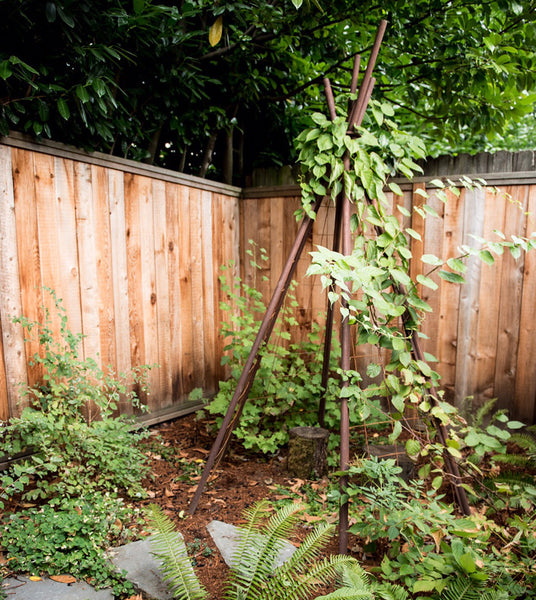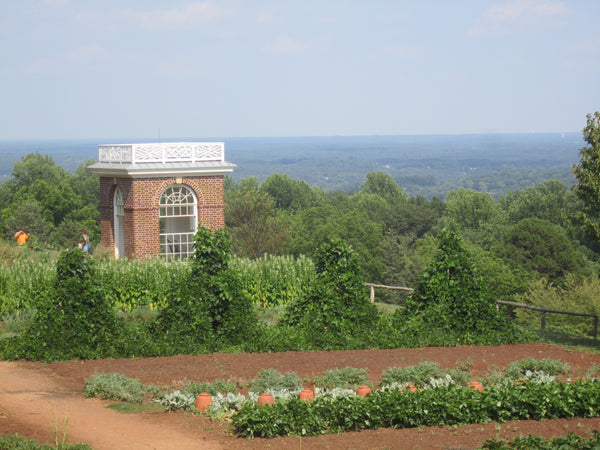Your garden is gorgeous, but is it making the best use of vertical space? Space-saving structures like garden tipis utilize centuries-old architectural elements and remain one of the best ways to preserve and protect climbing plants and vines while creating an eye-catching, sculptural effect in the garden.
History of the Tipi
The word tipi (originating from the Lakota word thípi, meaning dwelling) is sometimes phonetically spelled teepee or tepe in English. Marvelously designed, tips are portable conical tents made from wooden poles (historically lodgepole pines) covered by animal skins. These durable dwellings were largely used by indigenous people in the Great Plains and Canadian Prairies of North America.
(above) A Tipi structure as used by indigenous people of the Great Plains of North America. www.Tipi.org.
A Classic Garden Structure
The stable design of the tipi, it turns out, is also ideal for training climbing plants in the garden. In the middle ages, willow branches were woven into wattle for fences and trellises. Examples of such rustic trellising can still be observed in historical gardens like Thomas Jefferson’s Monticello in Virginia. Heavier woody vines (like wisteria, bougainvillea or climbing rose) require sturdier structures. Whatever the medium, “simple, appealing trellis designs that let the plants take center stage are generally most desirable,” writes Jessie Keith on Black Gold’s blog. Some of the most common vining vegetables to train on garden tipis include sweet potatoes, pole beans, cucumbers, squash, peas, and tomatoes. The right trellis not only looks good and makes harvesting easier, but can increase the production of your vegetable garden by preventing ground rot and encouraging scrambling plants like tomatoes to produce up instead of root sideways.

(above) Our Annabel Tipi Trellis is used as both a focal point and a destination in a lush woodland garden designed by Kirstien Forness of Fusion Landscape Design in Portland, Oregon. Growing on the tipi is a self-fertile Kiwi Issai. Photo by Debbie Baxter.
Jefferson’s Garden at Monticello
According to Thomas Jefferson’s garden records, he understood that when produce sits on the ground it is more susceptible to pests and disease. Monticello’s massive garden was divided into 24 different sections in geometric beds — many of them in an ancient Roman quincunx pattern — and made use of space-saving constructions like trellises. Today, “Jefferson’s favorite vining beans wind up a variety of sturdy cedar structures, which are an extrapolation from the scant records he left about arbors and other supports,” according to The New York Times.
(above) A line of Tipi trellises support edible plants in the vegetable gardens at Monticello.
“Slaves were essential to the creation and maintenance of the Monticello gardens, orchards and forests,” according to the The Daily Hampshire Gazette. “The 1,000-foot-long vegetable garden is a terrace carved from the hillside by a team of slaves by hard labor. Not only did slaves work in the Jefferson family gardens, they also tended their own small vegetable plots and each Sunday sold some of their produce to the Jeffersons.”
(above) Garden Tipis provide sturdy support for verdant edible vines growing in the gardens at Monticello.
At Monticello, Jefferson grew 170 varieties of fruits and 330 varieties of vegetables and herbs. He planted year round, tinkering with gardening techniques and exotic varieties of plants collected from his travels and friends. His perennial experiments produced a few successes, some failures, and a veritable encyclopedia of horticultural knowledge.
This knowledge, along with the original plans for the garden, has since been used to restore Monticello gardens their glory. Monticello’s restored grounds and gardens are currently open to the public to explore. Once an avid seed collector, Jefferson’s garden has also become a kind of seed bank, even supplying heirloom varieties to the beautiful and productive White House vegetable gardens.

(above) First Lady Michelle Obama harvests vegetables with students in the White House Kitchen Garden on the South Lawn. (Official White House Photo by Chuck Kennedy)
Benefits of Tipi Trellises
Thanks to pioneering horticulturists like Jefferson, you needn’t experiment in order to find the right kind of structure for your climbing plants. TerraTrellis’ designs are rooted in the historical construction of tipis, but are far more sturdy, stable, and durable. While traditional wood or bamboo tipis must be disassembled during winter months and rebuilt in the spring, TerraTrellis tipis are weather resistant and can remain in the garden year round. Climbing perennials that stay in place for many years (like clematis, jasmine, bougainvillea, grape or rose vines) require a sturdy material; TerraTrellis steel tipis are pre-engineered for stability and scale. Our tipis incorporate all of the benefits of the traditional structure while elevating it to an art piece through the use of color and architectural elements.

(above) Hannahdog and her beloved toy hedgehog like to hang out inside this Annabel Tipi Trellis in the urban garden of Los Angeles designer/artist Bianca D’Amico of Chapparal Studio. Bianca grows raspberry vines on the tipi and has filled her patio with sculptural succulents, citrus and bougainvillea.
See all of our colors and finishes here.





